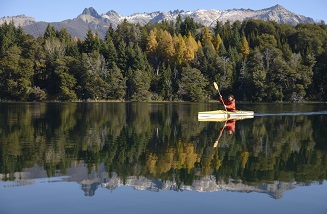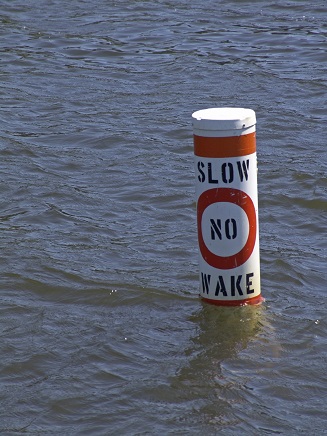Sharing Our Water

When you start sailing, you’ll navigate by looking where you want to go, and going there. Some people spend their whole sailing careers that way. But it’s a good idea to learn at least basic navigation— to be able to read a chart, plot a course and steer accurately by compass. It’s easy to learn, and you don’t need to be a mathematician. If you take a sailing course, the curriculum will include all the above, and more.
The magnetic needle on a compass always points to magnetic north; it tells you which way your boat is heading in relation to magnetic north. The compass card shows the 360 degrees of a circle, with steering marks usually every 5 degrees. A navigation chart is like a road map for the water. Charts come in different scales; you’ll want to use one that shows the area in considerable detail (1:20,000 is a good scale). A compass rose on the chart shows both true and magnetic north.
Here are some of the things you’ll see on a chart:
• A buoy, shown on a chart as a small diamond with a number next to it, marks a channel or a hazard, such as a shoal or rock. Green channel buoys ("cans") are odd-numbered; cone-shaped red buoys ("nuns") have even numbers. The rule of thumb in Canada for following buoys is, starting from the sea toward a harbour, "Red, right, returning"—leave red channel buoys to starboard as you enter a harbour or return upstream. Buoys with green and red horizontal stripes (called bifurcation buoys) mark the junction of two or more channels. There are many lighted (flashing) buoys and others that make noise with a bell, gong, or whistle. These characteristics are marked on the chart; for example, "Fl R 4sec BELL" is a bell buoy with a red light that flashes every 4 seconds. Unlighted daybeacons, located in the water or on land, also mark obstructions and harbour entrances.
• Charts also show water depths: white for deeper water, light blue for shallow water, and green is used to show marsh areas or no water at low tide. Depths at low tide are shown at frequent intervals. In addition, charts locate tall conspicuous objects that are easy to identify from the water - for example, church steeples, radio towers, and flagpoles.
Once you start sailing on your own, you should assemble a kit with essential navigation tools, especially if you’re going to rent boats. Few rentals have anything in the way of navigation equipment other than a compass, and sometimes not even that, so you’d better bring your own. Here’s what you need—it’s all available at any marine store:

• A current chart of the area where you’ll be sailing. Buy a most recent waterproof chart in the largest scale you can find: A large-scale chart covers a smaller geographical area, with lots more detail, than a small-scale chart. To purchase these find a marine chandlery (retail store) near you, or contact the Canadian Hydrographic Service (http://www.charts.gc.ca/pub/) to find out how to purchase one of their charts for the region you are interested in.
• A set of Parallel Rules, which is two rulers, hinged together in such a way that they remain parallel when the distance between them is adjusted. Before sailing, use your parallel rules to determine the latitude and longitude of key locations—where you’re sailing from, places you might want to go, etc.—and write them on the chart. Draw lines between key points, too, with the magnetic bearings, in both directions, written on the lines. It’s easier to do this ashore than on the boat; you’ll learn how to do it in your learn-to-sail program.
• A hand-bearing compass, which is a simple compass fitted with a sight. You point it at a lighthouse, landmark, etc., and read the direction—the “bearing”—to that object off the compass. Take bearings of two or more objects, plot them on your chart and where the lines cross is where you are. You won’t be doing this if you carry a GPS (see below), but if your rental boat has no compass, the hand-bearing compass can serve for steering, too.
• A simple handheld GPS. Old salts say you should learn to pilot with chart, parallel rules and dividers (an instrument used for measuring and transferring distances), and that’s true—but on a small boat, with no place to lay out the chart, the wind blowing and the spray flying, the GPS can be easier to work with. It will tell you where you are, what course you’re sailing and, if you input the latitude/longitude coordinates of a destination (you can do this ashore), how far away it is and in what direction. It works at night and in the fog, too. Be sure to house the GPS in a waterproof case, and bring spare batteries.
• A handheld marine VHF radio. If you get into trouble, the VHF is the fastest way to summon help; the Coast Guard, marine patrol, harbourmaster and other authorities all monitor VHF channel 16. You can also receive weather reports and forecasts. Buy a basic waterproof model, and charge the batteries before each sail.
Coastal piloting and navigation are fascinating subjects; the more extended your boating, the more expert you need to be. Electronic position-finding systems, such as GPS (the satellite-driven Global Positioning System) have simplified the navigator’s task.

